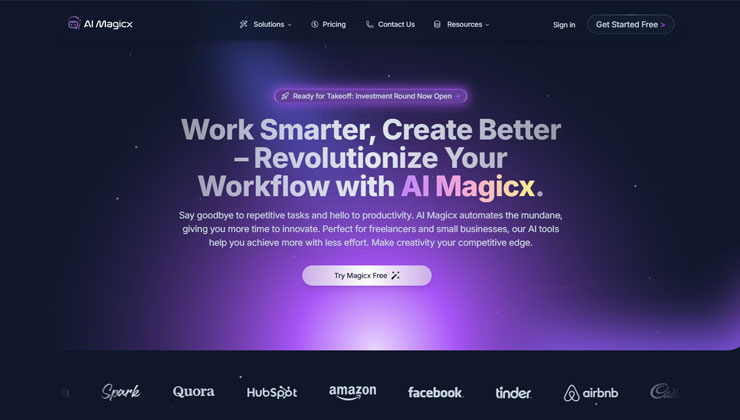To choose the right AI tool for your industry, identify your specific needs and evaluate tools based on those criteria. Research user reviews and compare features to make an informed decision.
Choosing the right AI tool can transform your business operations. With the growing number of AI solutions, it’s crucial to find one that fits your industry needs. Start by identifying the specific problems you aim to solve. Then, look for AI tools that offer features tailored to those challenges.
Evaluate user reviews and case studies to understand the tool’s effectiveness. Compare different options, focusing on usability, scalability, and customer support. Making a well-informed choice can enhance efficiency, reduce costs, and drive innovation in your industry.
Identifying Industry Needs

Choosing the right AI tool begins with understanding your industry needs. This step is essential for ensuring the tool fits your specific requirements. The following sections will guide you through the process of assessing your industry’s pain points and defining clear goals.
Assessing Pain Points
To choose the right AI tool, start by assessing pain points. Identify the challenges your industry faces. This helps in finding a tool that addresses these issues.
- List common problems in your industry.
- Talk to team members about their daily struggles.
- Analyze any gaps in your current processes.
Understanding pain points helps in selecting a tool that offers real value. Here’s a simple table to categorize your pain points:
| Pain Point | Impact | Current Solution |
|---|---|---|
| Data Management | High | Manual Entry |
| Customer Service | Medium | Email Support |
| Inventory Tracking | Low | Spreadsheets |
Defining Goals
Once pain points are clear, move on to defining goals. Goals should be specific and measurable. This helps in evaluating the effectiveness of the AI tool.
- Set clear objectives for using the AI tool.
- Identify key performance indicators (KPIs).
- Make sure goals align with your overall business strategy.
For example, if your goal is to improve customer service, define how you will measure success. This could be through reduced response times or increased customer satisfaction scores.
Here’s a simple way to structure your goals:
| Goal | KPI | Target |
|---|---|---|
| Improve Customer Service | Response Time | Under 2 minutes |
| Increase Sales | Conversion Rate | By 10% |
| Optimize Inventory | Stock Levels | Reduce by 15% |
Clearly defined goals ensure that you can track the impact of the AI tool effectively.
Evaluating Tool Features
Choosing the right AI tool for your industry involves careful evaluation. The features of the tool play a crucial role in determining its suitability. Let’s break down the key aspects to consider.
Must-have Functionalities
Every AI tool must have core functionalities. These are essential for effective operation.
- Data Processing: The tool must process large datasets quickly.
- Machine Learning: It should include machine learning algorithms.
- Integration: The tool must integrate with your existing systems.
- Security: Ensure it has strong data security features.
- Scalability: The tool should scale as your business grows.
Customization Options
Customization is vital for fitting the tool to your needs. Look for these options:
- User Interface: The interface should be customizable for ease of use.
- Algorithm Adjustments: You must be able to tweak algorithms as needed.
- Reporting: Customizable reporting features are very important.
- Workflow Integration: The tool should fit into your workflows seamlessly.
- API Access: Ensure it provides API access for further customization.
| Feature | Importance |
|---|---|
| Data Processing | High |
| Machine Learning | High |
| Integration | Medium |
| Security | High |
| Scalability | Medium |
By focusing on these features, you can select the best AI tool for your industry. Ensure the tool meets your needs and enhances your business processes.
Budget Considerations

Choosing the right AI tool for your industry involves several factors. One critical aspect is budget considerations. Understanding the costs is essential for making an informed decision. Let’s break down the financial components to consider.
Initial Costs
The initial costs of AI tools can vary widely. These costs can include:
- Software Purchase: The price of the AI software itself.
- Setup Fees: Costs for installation and configuration.
- Training: Expenses for training your team to use the tool.
Some AI tools may offer free trials or basic versions. This can help you evaluate the tool without a big investment upfront. Always compare the features of different tools before making a purchase.
Long-term Investment
Long-term investment is another crucial factor. Consider the following:
| Cost Type | Description |
|---|---|
| Subscription Fees: | Monthly or yearly fees for continued use. |
| Maintenance: | Ongoing costs for updates and technical support. |
| Scalability: | Extra costs for scaling the tool as your needs grow. |
It’s important to understand the full scope of these costs. A tool with a low initial cost may have high long-term expenses. Always think about the total cost of ownership over time.
Scalability And Integration
Choosing the right AI tool for your industry involves several crucial factors. Two important aspects to consider are scalability and integration. These factors ensure the AI tool can grow with your business and fit seamlessly into your existing systems.
Future Growth
Scalability is vital for future growth. Your AI tool should be able to handle an increasing amount of data and tasks. This means it should grow as your business grows. Look for AI tools that offer flexible plans. These plans should allow you to upgrade easily.
Consider the potential for your business to expand. A scalable AI tool will save you time and money in the long run. It will prevent the need to switch to a new tool as you grow. This ensures that your operations continue smoothly.
Compatibility With Existing Systems
Integration with existing systems is another key factor. Your AI tool should work well with the software and hardware you already have. This ensures a smooth transition and minimizes disruptions.
Check if the AI tool supports APIs. APIs allow different software systems to communicate. They make integration easier. Also, look for tools that offer plugins or extensions for popular platforms.
Here’s a simple table to help you evaluate compatibility:
| Criteria | Questions to Ask |
|---|---|
| APIs | Does the tool support APIs? |
| Plugins | Are there plugins for your existing platforms? |
| Data Formats | Can it handle your data formats? |
Choosing a tool that integrates well with your current systems will save you headaches. It will also make your team more productive.
Vendor Reputation

Choosing the right AI tool for your industry can be challenging. One critical factor to consider is the vendor reputation. A reputable vendor ensures reliability, quality, and support. Understanding vendor reputation helps avoid risks and ensures long-term success with AI tools.
Customer Reviews
Customer reviews provide insights into a vendor’s reliability. Look for reviews on trusted websites and forums. Pay attention to both positive and negative feedback.
- Positive reviews indicate customer satisfaction.
- Negative reviews highlight potential issues.
- Mixed reviews show areas for improvement.
Consider reviews from businesses in your industry. This ensures relevance and helps gauge the tool’s effectiveness.
Case Studies
Case studies showcase real-world applications of AI tools. They demonstrate how the tool solves industry-specific problems. Reviewing case studies helps understand the tool’s potential impact.
| Industry | Problem Solved | Results |
|---|---|---|
| Healthcare | Patient Data Management | Improved efficiency by 30% |
| Finance | Fraud Detection | Reduced fraud by 25% |
| Retail | Customer Analytics | Increased sales by 15% |
Look for case studies relevant to your industry. This helps gauge the tool’s effectiveness and suitability.
User Experience
Choosing the right AI tool for your industry involves many factors. One of the most crucial is user experience. A tool that is easy to use and well-supported can make a big difference. Let’s explore this through the following aspects:
Ease Of Use
The AI tool should be easy to navigate. A simple and intuitive interface saves time. Users should not need extensive training to get started. Drag-and-drop features are very helpful. Customizable dashboards can enhance the user experience.
- Simple setup process
- Intuitive interface
- Customizable dashboards
- Drag-and-drop features
These features make the tool accessible to everyone. This can lead to higher adoption rates within your team.
Support And Training
Excellent support and training are key for any AI tool. Look for tools that offer comprehensive help. This can include:
- 24/7 customer support
- Detailed documentation
- Online tutorials and webinars
- Community forums
These resources can help resolve issues quickly. Training programs can also boost user confidence. This ensures that your team can use the tool effectively.
| Feature | Importance |
|---|---|
| 24/7 Customer Support | High |
| Online Tutorials | Medium |
| Community Forums | Low |
Providing training and support can make the difference between success and failure. Make sure the AI tool you choose offers these benefits.
Security And Compliance
Choosing the right AI tool for your industry involves many factors. One of the most critical aspects is Security and Compliance. Ensuring your AI tool adheres to industry standards protects your data and keeps you compliant with regulations.
Data Protection
Data protection is crucial in any industry. Your AI tool should offer robust security features to safeguard sensitive information. Here are some key points to consider:
- Encryption: Ensure the tool uses advanced encryption methods.
- Access Controls: Look for tools with role-based access control.
- Data Backup: Verify if the tool offers reliable backup solutions.
Data breaches can have severe consequences. Ensuring your AI tool has strong data protection measures can prevent unauthorized access and data loss.
Regulatory Requirements
Each industry has specific regulatory requirements to follow. Your AI tool must comply with these regulations to avoid penalties. Some important considerations include:
- Industry Standards: Ensure the tool meets industry-specific standards.
- Compliance Certifications: Verify if the tool has the necessary certifications.
- Audit Trails: Check if the tool offers detailed audit logs.
Adhering to regulatory requirements is essential for maintaining your business’s reputation and avoiding legal issues. Make sure your chosen AI tool supports compliance with relevant laws and guidelines.
Below is a table summarizing the key aspects of Security and Compliance:
| Aspect | Key Considerations |
|---|---|
| Data Protection | Encryption, Access Controls, Data Backup |
| Regulatory Requirements | Industry Standards, Compliance Certifications, Audit Trails |
Making The Final Decision

Deciding on the right AI tool is crucial for your industry. You need to ensure the tool meets your needs and integrates well. This section will help you make an informed decision.
Trial Period
Many AI tools offer a trial period. This allows you to test the tool before committing. During this period, you should:
- Evaluate the tool’s performance in real-world scenarios.
- Check the user interface and ease of use.
- Assess the customer support and available resources.
Use the trial period to gather feedback from your team. This will help you decide if the tool fits your needs.
Stakeholder Buy-in
Getting stakeholder buy-in is essential. Stakeholders include managers, team members, and key decision-makers. Here’s how to gain their support:
- Present the benefits of the AI tool.
- Show how the tool can solve problems.
- Demonstrate potential cost savings and efficiency gains.
Engage stakeholders early in the process. Their support is crucial for successful implementation.
Use these steps to make a well-informed decision. The right AI tool will boost your efficiency and success.
Frequently Asked Questions
How To Choose The Right AI Tools?
To choose the right AI tools, identify your needs and budget. Research features and read user reviews. Test trial versions for compatibility. Prioritize scalability and support options. Ensure strong security measures.
How Do I Know If AI is Right For My Business?
Evaluate your business needs, goals, and data. Identify repetitive tasks. Assess potential ROI and consult experts.
How To Choose An AI Solution?
Choose an AI solution by defining your needs, evaluating features, checking scalability, considering integration capabilities, and reviewing customer support.
How To Use AI in the Industry?
Use AI in industry to automate processes, analyze data, improve efficiency, and enhance decision-making. Integrate AI for predictive maintenance, quality control, and customer service. Employ machine learning models for better insights and innovation.
Conclusion
Choosing the right AI tool is crucial for your industry. Evaluate features, scalability, and support options. Prioritize tools that align with your business goals. Doing thorough research will ensure a perfect fit. Implementing the right AI can significantly boost efficiency and growth.
Make an informed decision for long-term success.






